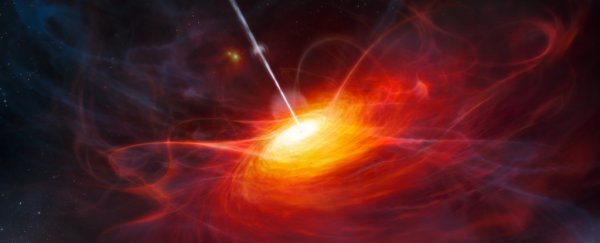For the first time, astronomers have used supermassive black holes from just after the Big Bang to measure the expansion rate of the Universe. Now, we have a bigger mystery on our hands than the answer this effort provided.
It turns out the Universe is growing faster than expected. This could mean that the dark energy thought to drive the acceleration of this expansion, also sometimes interpreted as the cosmological constant described by Albert Einstein, is not so cosmologically constant after all.
Instead, it could be growing stronger.
The Universe's rate of expansion is called the Hubble Constant, and it's been incredibly tricky to pin down. Every test seems to come up with a different result; recently, data from the Planck satellite that measured the cosmic microwave background set it at 67.4 kilometres (41.9 miles) per second per megaparsec, with less than 1 percent uncertainty.
Other methods typically involve the use of 'standard candles', objects with known luminosity such as cepheid variable stars or Type Ia supernovae, from which distance can be calculated based on their absolute magnitude.
Last year a cepheid variable star calculation of the Hubble Constant returned a result of 73.5 kilometres (45.6 miles) per second per megaparsec. So you can see why astronomers keep poking this weird cosmic bear.
But a few years ago, astronomers realised that the distance to another object could be calculated accurately, too. Enter quasars, along with their black holes.
Quasars are among the brightest objects in the Universe. Each is a galaxy that orbits a supermassive black hole actively feeding on material. Its light and radio emissions are caused by material around the black hole, called an accretion disc, which emits intense light and heat from friction as it swirls like water circling a drain.
They also emit X-ray and ultraviolet light; and, as discovered by astronomers Guido Risaliti of Università di Firenze, Italy, and Elisabeta Lusso of Durham University, UK, the ratio of these two wavelengths produced by a quasar varies depending on the ultraviolet luminosity.
Once this luminosity is known, as calculated from that ratio, the quasar can be used just like any other standard candle.
And that means we can measure farther back into the Universe's history.
"Using quasars as standard candles has great potential, since we can observe them out to much greater distances from us than Type Ia supernovae, and so use them to probe much earlier epochs in the history of the cosmos," Lusso said.
The researchers compiled UV data on 1,598 quasars from just 1.1 billion to 2.3 billion years after the Big Bang, and used their distances to calculate the expansion rate of the early Universe.
They also cross-checked their results against the Type Ia supernova results that cover the more recent 9 billion years, and found similar results where they overlapped. But, in the early Universe, where only quasars provide measurements, there was a discrepancy between what they observed, and what was predicted based on the standard cosmological model.
"We observed quasars back to just a billion years after the Big Bang, and found that the Universe's expansion rate up to the present day was faster than we expected," said Risaliti.
"This could mean dark energy is getting stronger as the cosmos grows older."
We don't really know what dark energy is - we can't see it or detect it. It's just the name we give to the unknown repulsive force that seems to be accelerating the Universe's expansion over time.
(Based on that expansion rate, astrophysicists have calculated that dark energy constitutes around 70 percent of the Universe - so a more accurate expansion rate will also give us a more accurate calculation of dark energy volume.)
If the density of dark energy is increasing over time, the scientists think it would mean that it's not Einstein's cosmological constant after all. But it would explain the strange numbers - and maybe even the discrepancy between previous Hubble Constant results.
For now, there's a lot more work to be done to test this result and see if it holds firm.
"This model is quite interesting because it might solve two puzzles at once, but the jury is definitely not out yet and we'll have to look at many more models in great detail before we can solve this cosmic conundrum," Risaliti said.
"Some scientists suggested that new physics might be needed to explain this discrepancy, including the possibility that dark energy is growing in strength. Our new results agree with this suggestion."
The team's research has been published in the journal Nature Astronomy, and can be read in full on preprint resource arXiv.
